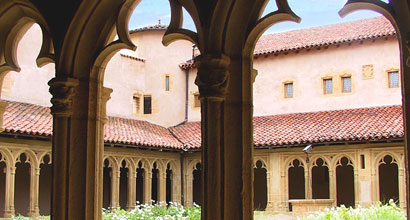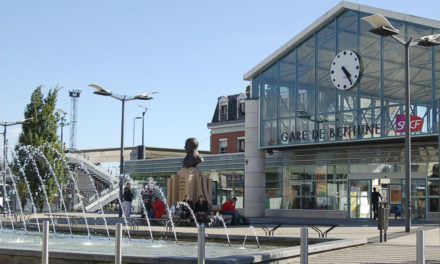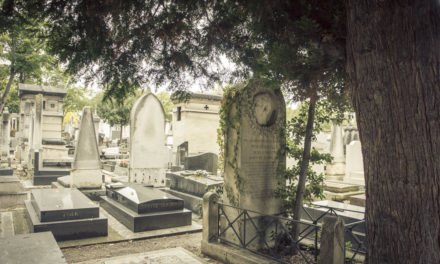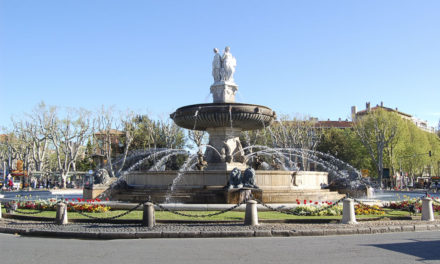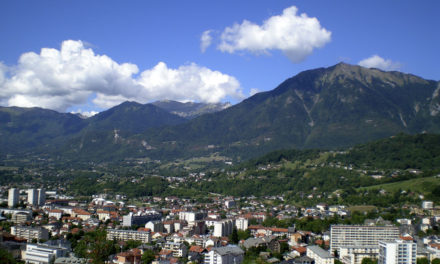‘Monks were masters of the town’ a panel helpfully informs you in the Centre des Visiteurs (t 04 77 60 09 97, www.amisdesartscharlieu.com), just in case you’d wandered, eyes shut, through Charlieu to reach this modern museum housed in part of the former Benedictine priory, the oldest, most venerable religious establishment in a town clearly once packed with monks. This carus locus (beloved spot, hence the name, Charlieu) developed one of the most glorious, golden-stoned legacies of monasteries in southeast France. A significant merchant community also established itself here early, all fortified.
Hotels in Charlieu
History
The Benedictine priory may have suffered the most at the Revolution, but its entrance, or narthex, has retained some of the most memorable Romanesque carvings in France. Above the main doorway, a thick-fleeced Paschal Lamb (more an old sheep in fact, but symbolic of Christ all the same) peers down half-wise, half-dumb, from amidst a band of stone patterns so finely carved as to resemble cloth. Christ appears in person below. Further scenes represent the wedding at Canaa and Christ’s Transfiguration. Although many of the figures were decapitated, they remain full of life. The priory’s possible 9th-century founder, Bishop Ratbert, and King Boson of Burgundy and Provence, a major contemporary benefactor, may count among the faces depicted below. The mighty abbey of Cluny, whose power spread from nearby southern Burgundy right across Europe, took control of the establishment from the mid-10th century, after which it was repeatedly rebuilt.
Just a few of the priory’s later medieval buildings still stand behind the narthex, transformed into the modern Centre des Visiteurs, presenting a helpful overview of the various monastic orders established in the area and of the monks’ daily life. Via the centre, visit the cloister, the chapter house and the priors’ chapel, plus a small surviving section of the 11th-century church, with its own tympanum of the Apocalpyse, and the most enchanting carving of the sun and the moon, the latter represented childlike, as a face covering its eyes with its hands! Back outside, the odd remaining rampart tower and the courtyard of the prior’s lodgings, add to the special atmosphere of this corner of town.
Architecture
In Charlieu centre, fine stone and timber-frame buildings have been turned into tempting shops. Pralus puts on a divine chocolate display in the ornate Maison des Anglais, English headquarters during the Hundred Years’ War. The local meat speciality, andouillettes de Charlieu, is not for the squeamish. On Charlieu’s main square, the 13th-century church of St-Philibert, its attractive tympanums heavily restored, survived the Revolution much better than the priory. It contains remarkable decorations, notably late-Gothic stalls depicting banner-carrying, beautifully robed saints.
The town has a long history of weaving. In the 1820s, silk-making was established here as the workers in Lyon were kicking up a fuss, the story recalled at the Musée de la Soierie (t 04 77 60 28 84) which has taken over much of an 18th-century hospital. A corridor of haute couture silk dresses made in town includes an Yves St-Laurent leopard-silk number for Catherine Deneuve. Small pieces of silk are on sale too. The rooms of the Musée Hospitalier present something of a sanitised version of hospital history, each scented with sweet medicinal herbs.
Couvent des Cordeliers
In Charlieu’s western outskirts, the 14th-century Couvent des Cordeliers (t 04 77 60 07 42) calls for a last religious halt. The church is typically Franciscan, big and plain, but decorated with worn fragments of Gothic paintings, while one side of the cloisters is enlivened by comical cautionary tales in stone.
For more information on the area, and the département of the Loire, consult the Cadogan guide to the Rhône-Alpes.
Copyright text Philippe Barbour 2011.
Copyright Images : upperloirevalley.com

